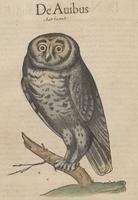Care of Magical Creatures
Warning message
You must
authorize Drupal to use your Google Analytics account before you can view reports.
Primary tabs
-

-
Aldrovandi's Dragons
-
Italian naturalist Ulisse Aldrovandi (1522-1605) kept an impressive cabinet of curiosities that purportedly included a dragon specimen. When he died, he left his collection to the city of Bologna. The collection was later maintained by Bartolomeo Ambrosini, who published the naturalist's volume on serpents and dragons after Aldrovandi's death. Aldrovandi deliberately produced large-format books with spacious woodcuts, allowing him to render his subjects in the appropriate size according to their appearances in real life or in this case, stature. On the top is one of Aldrovandi's Ethiopian dragons, and below, a dragon modeled after Ambroise Paré's dragon, expanded for effect. We're sure Charlie Weasley would love to meet these fire-breathing
Show moreItalian naturalist Ulisse Aldrovandi (1522-1605) kept an impressive cabinet of curiosities that purportedly included a dragon specimen. When he died, he left his collection to the city of Bologna. The collection was later maintained by Bartolomeo Ambrosini, who published the naturalist's volume on serpents and dragons after Aldrovandi's death. Aldrovandi deliberately produced large-format books with spacious woodcuts, allowing him to render his subjects in the appropriate size according to their appearances in real life or in this case, stature. On the top is one of Aldrovandi's Ethiopian dragons, and below, a dragon modeled after Ambroise Paré's dragon, expanded for effect. We're sure Charlie Weasley would love to meet these fire-breathing fellows.
Show less
-

-
Aldrovandi's Mer-Couple
-
The classical tradition that attested to the realness of mermaids continued well into the seventeenth century, with sources like Ulisse Aldrovandi's Monstrorum historia documenting sightings of the creatures. Pliny also reported documentary evidence of Sirens, the beguiling mermaids who lured sailors with song to their deaths along the Nile (note the couple is called the Monstra Niliaca Parei). J.K. Rowling's colony of mer-people at the Black Lake use their voices to deliver a vital clue during the TriWizard Tournament.
-

-
Aldrovandi's Snakes
-
If the Sorting Hat sent you to Slytherin in first year, no doubt you'll be charmed by these two fabulously scaly serpents, who seem almost to wriggle right off the pages of Ulisse Aldrovandi's 1640 volume on snakes and dragons. Fear not if you're not a fan of Slytherin's mascot: the common Aesculepian snake (left) and the black Aesculepian snake (right) aren't venomous. Aldrovandi reopens the debate about snake generation in this book, puzzling over the suggestion that snakes come from the eggs of a rooster. Is there a Parselmouth in the house? We'll just have to ask.
-

-
Centaur Almanac
-
For many nineteenth-century Americans, almanacs produced by patent medicine manufacturers were a trusted source of information, distributed annually by the local pharmacy. By the nineteenth century, many manufacturers produced almanacs with arresting designs featuring plants and animals in eye-catching colors. Pharmaceutical almanacs combined calendars, weather predictions, and horoscopes with advertisements and testimonials for products. This almanac, produced by Centaur Liniments, promoted a medication that promised to remedy a long list of ailments. Good leisure reading for that centaur colony near Hogwarts—within these pages they'd find predictions of the planets' brightest days, which could ease viewing through the thick cover of the
Show moreFor many nineteenth-century Americans, almanacs produced by patent medicine manufacturers were a trusted source of information, distributed annually by the local pharmacy. By the nineteenth century, many manufacturers produced almanacs with arresting designs featuring plants and animals in eye-catching colors. Pharmaceutical almanacs combined calendars, weather predictions, and horoscopes with advertisements and testimonials for products. This almanac, produced by Centaur Liniments, promoted a medication that promised to remedy a long list of ailments. Good leisure reading for that centaur colony near Hogwarts—within these pages they'd find predictions of the planets' brightest days, which could ease viewing through the thick cover of the Forbidden Forest's trees.
Show less
-

-
Gessner's Owl
-
Tucked among the magical storehouses of Diagon Alley is a shop that is always dark in order to accommodate the preferences of its nocturnal inhabitants. This is Eeylops Owl Emporium—and the setting for Harry Potter's adoption of his pet, Hedwig, who remains one of his truest companions throughout his school years. The Swiss naturalist Conrad Gessner depicted many owls in his volume dedicated to birds, including this handsome grey owl with his abundance of downy feathers and keenly intelligent eyes. Owls of all types appear throughout the series, retaining the cultural associations they've had for centuries of both wisdom and omens.
-

-
Gessner's Unicorn
-
The Swiss naturalist Conrad Gessner's 4,500-page encyclopedia of animals, the Historia Animalium, makes even the prolific Gilderoy Lockhart look like a slouch. Part fantasy, part observation, Gessner's dense and exuberant animal kingdom included creatures real and imaginary, running the gamut from sea monsters and whales to diminutive tabby cats. Of the unicorn, Gessner writes that its horn marrow, cut with a little wine, could heal a man who'd eaten a poisoned cherry, and could cure a number of ailments. All the better to keep young wizards out of the Hogwarts hospital wing.
-

-
Kircher's Three-headed Dog
-
This engraving, found in Athanasius Kircher's two volume work on music, depicts Orpheus playing the hellhound Cerberus to sleep in order to gain passage to the Underworld. In classical sources, Cerberus was not usually so easily tamed: to the Greeks, he was a monstrous three-headed dog. A glance at Cerberus was said to petrify humans, and his bite was poisonous. Most Greek sources describe Cerberus as possessing three heads, as does Fluffy, the fearsome guard dog who blocks passage to the underground vault guarding the philosopher's stone. Spoiler alert: Harry and his friends take a cue from Orpheus's book and soothe Hogwarts' vicious pup by picking a drowsy tune.
-

-
Lykosthenes' Salamander
-
Konrad Lykosthenes tells us in 1557 that the salamander has a highly toxic venom, so strong it would taint all of the fruit on a tree it climbed. He also connects the animal with fire, arguing that the salamander can put out flames with its touch. In Harry Potter and the Chamber of Secrets, salamanders are born from flames; Fred and George also feed one fireworks as a prank, and it releases tangerine stars (not inappropriate given the stellar designs on this fellow's back). Don't let the twins give you any ideas or that'll be ten points from Gryffindor.
-

-
Paré's Mermen
-
Early modern naturalists frequently relied on seafarers' tales of ocean voyages to augment their knowledge of sea life. The French surgeon Ambroise Paré's work included the figures of the monkfish and the bishop fish, which, apart from their fin-like arms and abundance of scales, resembled human clergyman. High-Inquisitor Dolores Umbridge might have referred to the mer-people and centaurs in Paré's book as "half-breeds"— creatures that were isolated, because of their hybrid forms, from the wizarding community.
-

-
Pomet's Unicorns
-
If you visit Mr. Mulpepper's or Slug & Jiggers Apothecary in Diagon Alley, among the remedies available for a few scant Galleons is unicorn horn. In his comprehensive catalog of plants and animals used for medicinal purposes, the French apothecary Pierre Pomet identifies five species of unicorns, though he is quick to admit that most unicorn horns sold in shops are probably from narwhals. Narwhal or not, these horns were worn as protective amulets, used to cure fevers and rout poisons. They were also displayed as curiosities in pre-Revolution-era France.
-

-
Spider, Hortus Sanitatis
-
Even arachnophobes may be well-disposed to this spider, who dates to the 1499 publication of the Hortus Sanitatis (here he appears in our 1517 edition). Spiders were often depicted in early printed books using pictographic shapes, drawing on an earlier medieval tradition. Here, our spider scrambles up a tightly circular web, his thorax evenly studded in a grid design. He may not look scary, but the accompanying text offers strong evidence that this spider might have caused worry, just as J.K. Rowling's giant spider Aragog did. The authors of this early modern tome included several botanical remedies for spider bites.
-

-
Two Dragons from Ambroise Paré
-
Anatomist, surgeon, and inventor Ambroise Paré's collected works, first published in 1575, offer illustrations of many medical anomalies along with strange and exotic creatures. Among them, Paré singles out dragons, placing all bets on these fierce, fantastical creatures in theoretical battles with elephants and birds of prey. Paré writes, "Pliny saith, that there are Dragons found in Aethiopia of ten Cubits long, but that in India there are Dragons of an hundred foot long, that fly so high, that they fetch Birds, and take their prey even from the midst of the clouds." With such a range of species, we're happy Hagrid's egg hatched the Norwegian Ridgeback Norbert, who, despite some destructive tendencies, was a pretty swell guy.












